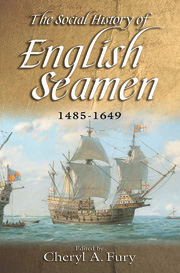Book contents
- Frontmatter
- Contents
- Illustrations
- Contributors
- List of Abbreviations
- Introduction
- 1 The English Maritime Community, 1500–1650
- 2 The Work of G.V. Scammell
- 3 The Men of the Mary Rose
- 4 Tudor Merchant Seafarers in the Early Guinea Trade
- 5 The Elizabethan Maritime Community
- 6 The Religious Shipboard Culture of Sixteenth and Seventeenth-Century English Sailors
- 7 Health and Health Care at Sea
- 8 The Relief of English Disabled Ex-Sailors, c. 1590–1680
- 9 Seamen's Wives and Widows
- 10 Jacobean Piracy: English Maritime Depredation in Transition, 1603–1625
- Conclusion
- Bibliography
- Index
1 - The English Maritime Community, 1500–1650
Published online by Cambridge University Press: 05 September 2013
- Frontmatter
- Contents
- Illustrations
- Contributors
- List of Abbreviations
- Introduction
- 1 The English Maritime Community, 1500–1650
- 2 The Work of G.V. Scammell
- 3 The Men of the Mary Rose
- 4 Tudor Merchant Seafarers in the Early Guinea Trade
- 5 The Elizabethan Maritime Community
- 6 The Religious Shipboard Culture of Sixteenth and Seventeenth-Century English Sailors
- 7 Health and Health Care at Sea
- 8 The Relief of English Disabled Ex-Sailors, c. 1590–1680
- 9 Seamen's Wives and Widows
- 10 Jacobean Piracy: English Maritime Depredation in Transition, 1603–1625
- Conclusion
- Bibliography
- Index
Summary
The maritime community lacked clarity of definition. In one sense it embraced all those merchants who sent a proportion of their goods by sea, either abroad or coastwise, and in another sense all the bargemen and wherrymen who transported commodities inland along the river systems. When we consider that boats of up to fifteen tons burthen (in other words large enough to go to sea) could penetrate inland as far as Bedford, and that something like ten counties were served by the Great Ouse and its tributaries, we realize how flexible the concept of a maritime community could be. Kings Lynn has been described as the ‘gateway to a fifth of England’. After 1536 every county with a seacoast was for certain purposes subject to the jurisdiction of a Vice-Admiral, whose job it was to catch pirates, adjudicate seafarers disputes and administer prize law, using delegated authority from the Court of the High Admiral. Justices of the Peace in such counties would have been accustomed to refer a proportion of the cases which came before them to that jurisdiction. However, the Vice-Admirals powers were defined functionally rather than territorially, and it would be unreasonable to think of the whole of Hampshire or Norfolk, often far from the rivers, as belonging to the maritime community. More realistically, it consisted of those who earned their living from the sea, but even such a definition is imprecise. Any merchant who shipped even part of a cargo, or who had a share in the ownership of a vessel, would belong, as would any family whose runaway son went to sea.
- Type
- Chapter
- Information
- The Social History of English Seamen, 1485-1649 , pp. 5 - 26Publisher: Boydell & BrewerPrint publication year: 2012



